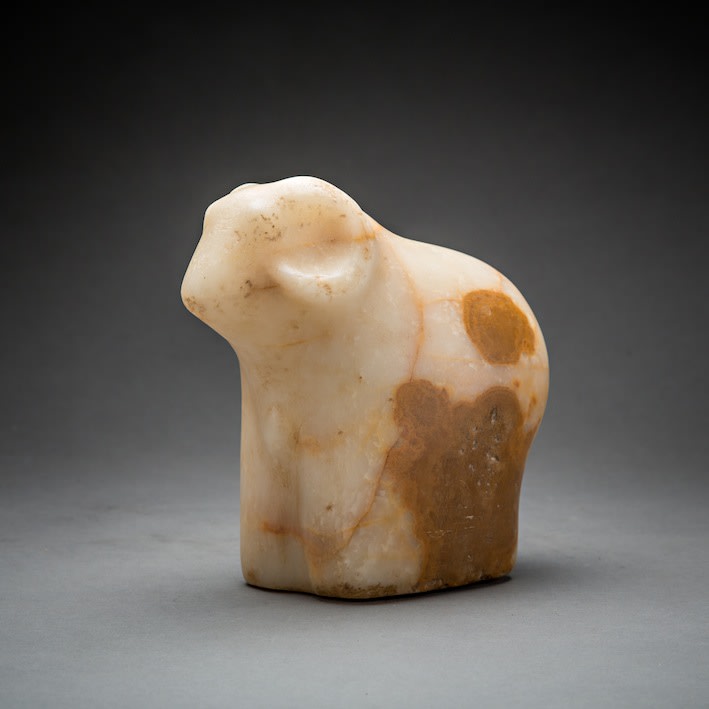South Arabian Alabaster Sculpture of a Ram, 3000 BCE - 2000 BCE
Alabaster
height 17.3 cm
height 6 3/4 in
height 6 3/4 in
LA.510
Minimally emerging from a decorative block of tawny-flecked alabaster, the forms of this ram are both powerful and true to nature. The sculptor has concentrated his attention on the tall,...
Minimally emerging from a decorative block of tawny-flecked alabaster, the forms of this ram are both powerful and true to nature. The sculptor has concentrated his attention on the tall, powerful legs which support a foreshortened body from which rises a majestically detailed head. The snout, eyes, and horns are clearly articulated, and the head is prominently raised and set off from the body. The overall aesthetic sensibility of this finely-polished work of art is utterly modern and charming.
On the basis of its material, style, and dimensions, this ram can be assigned to the Sabaean Culture which flourished in the Arabian Peninsula contemporary with the civilization of the Roman Empire. The Sabaeans had a predilection for animal sculpture but their repertoire generally consists of depictions of both the ibex and bull. Free-standing representations of other animals, such as our ram, are exceeding rare and exceptional; there were no rams of this type featured in the recent touring exhibition of the ancient art of Yemen.
In the Sabaean Culture, these animals were associated with principal deities of the South Arabian pantheon, but as recent scholarship has demonstrated, very little is known about the great number of local deities worshipped by the Sabaeans. There is some speculation that some of these deities were associated with celestial bodies such as the sun, the moon, and certain stars.
Be that as it may, the Sabaean culture has long been associated with the legendary Queen of Sheba whose encounter with King Solomon of the Bible (I Kings 10:1-13 and 2 Chronicles 9:1-12) is well-known, having served repeatedly as a fitting subject for Western artists and Hollywood moguls. This delightful ram, a significant work of art in its own right, serves as an artful reminder of that famed Biblical episode, and is representative of a culture whose art is now only being recognized by serious collectors.
References:
St. John Simpson [editor], Queen of Sheba. Treasures from Ancient Yemen (London 2002)
On the basis of its material, style, and dimensions, this ram can be assigned to the Sabaean Culture which flourished in the Arabian Peninsula contemporary with the civilization of the Roman Empire. The Sabaeans had a predilection for animal sculpture but their repertoire generally consists of depictions of both the ibex and bull. Free-standing representations of other animals, such as our ram, are exceeding rare and exceptional; there were no rams of this type featured in the recent touring exhibition of the ancient art of Yemen.
In the Sabaean Culture, these animals were associated with principal deities of the South Arabian pantheon, but as recent scholarship has demonstrated, very little is known about the great number of local deities worshipped by the Sabaeans. There is some speculation that some of these deities were associated with celestial bodies such as the sun, the moon, and certain stars.
Be that as it may, the Sabaean culture has long been associated with the legendary Queen of Sheba whose encounter with King Solomon of the Bible (I Kings 10:1-13 and 2 Chronicles 9:1-12) is well-known, having served repeatedly as a fitting subject for Western artists and Hollywood moguls. This delightful ram, a significant work of art in its own right, serves as an artful reminder of that famed Biblical episode, and is representative of a culture whose art is now only being recognized by serious collectors.
References:
St. John Simpson [editor], Queen of Sheba. Treasures from Ancient Yemen (London 2002)



